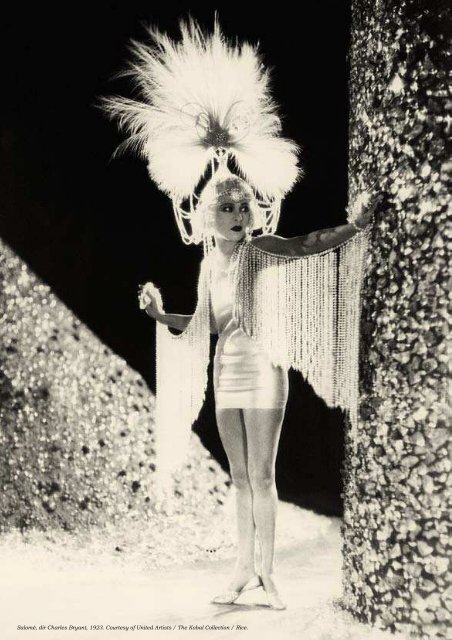Download the full program as PDF - Fashion Film Festival
Download the full program as PDF - Fashion Film Festival
Download the full program as PDF - Fashion Film Festival
Create successful ePaper yourself
Turn your PDF publications into a flip-book with our unique Google optimized e-Paper software.
Salomé, dir Charles Bryant, 1923. Courtesy of United Artists / The Kobal Collection / Rice.<br />
4:30pm<br />
salomé<br />
Dir. Charles Bryant, 1923, 74 mins.<br />
With Alla Nazimova, Mitchell Lewis<br />
Costume and sets by Natacha Rambova<br />
With an introduction to <strong>the</strong> work of Natacha<br />
Rambova by Pat Kirkham<br />
Accompanied by music from Donald<br />
Sosin<br />
The cult status that Salomé enjoys today<br />
owes much to <strong>the</strong> outlandish, highly<br />
stylised sets and costumes à la Aubrey<br />
Beardsley. The designer Natacha Rambova<br />
w<strong>as</strong> a protégé of <strong>the</strong> lead actress<br />
and producer Nazimova who reportedly<br />
sank much of her own money in <strong>the</strong> film.<br />
Despite being a box-office failure <strong>the</strong><br />
film remains a landmark in <strong>the</strong> history<br />
of cinema, bridging <strong>the</strong> mainstream and<br />
<strong>the</strong> avant-garde. Its radical modernist<br />
aes<strong>the</strong>tic, camp stylisations and deliberately<br />
exaggerated acting is a departure<br />
from <strong>the</strong> turn-of-<strong>the</strong>-century portrayals<br />
of Salomé <strong>as</strong> an overtly eroticized<br />
seductress. Nazimova’s film is arguably<br />
less exhibitionist than it is a comment<br />
on exhibitionism (one reviewer even complained<br />
it had little worthy of censorship)<br />
<strong>as</strong> it <strong>the</strong>matizes looking, voyeurism,<br />
and transgressive sexual desire—an apt<br />
homage to Oscar Wilde indeed.<br />
6:30pm<br />
F<strong>as</strong>hions of 1934<br />
Dir. William Dieterle, 1934<br />
With William Powell, Bette Davis.<br />
Costume by Orry-Kelly, musical numbers<br />
by Busby Berkeley.<br />
New 35mm print courtesy of <strong>the</strong> Packard<br />
Humanities Institute.<br />
F<strong>as</strong>hions of 1934 is one of a long line<br />
of films from <strong>the</strong> 1930s and 1940s that<br />
exploited <strong>the</strong> success of New York’s super-revues<br />
such <strong>as</strong> <strong>the</strong> Ziegfeld Follies<br />
and Frolics, <strong>the</strong> Earl Carroll Vanities,<br />
or George White’s Scandals. Its musical<br />
F<strong>as</strong>hions of 1934, dir William Dieterle, 1934. Courtesy of Warner Bros / The Kobal Collection.<br />
number “Spin a Little Web of Dreams”<br />
h<strong>as</strong> Busby Berkeley’s signature all over<br />
it—here he combined to great effect<br />
<strong>the</strong> sensuousness of <strong>the</strong> follies’ costuming<br />
and décor with his trademark<br />
kaleidoscopic choreography. As if this<br />
w<strong>as</strong> not enough, <strong>the</strong> film displays some<br />
remarkable gowns courtesy of Hollywood<br />
favourite, Orry-Kelly (who himself<br />
had designed sets and costumes for <strong>the</strong><br />
Scandals). As its title suggests, F<strong>as</strong>hions<br />
of 1934 is set in <strong>the</strong> f<strong>as</strong>hion industry<br />
and h<strong>as</strong> a good old dig at many<br />
a sensitive issue at its heart – from<br />
creativity versus commerce, originality<br />
versus copy and exclusivity versus<br />
m<strong>as</strong>s-availability, to <strong>the</strong> rivalry between<br />
Paris and New York.


